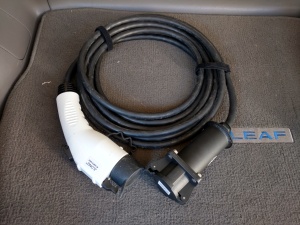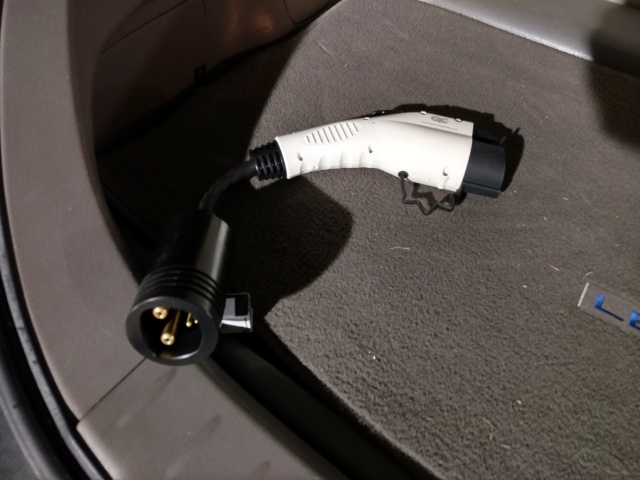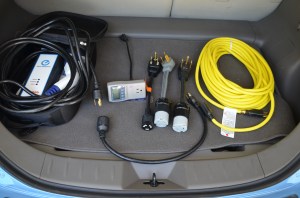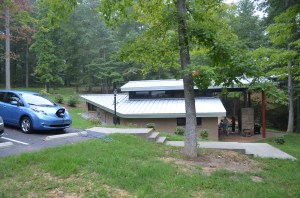As a new EV driver one seldom drives further than half the total vehicle range, i.e. you can go to and fro from your destination without having to charge the vehicle. With increased confidence as to how far the vehicle will go on a single charge, you find yourself venturing past ‘the point of no return’ where a remote charge is necessary to complete your journey.
Some downtown areas have plenty of choices when it comes to EV charging. More remote and rural destinations may require one to plug the vehicle in using the portable charging unit that comes with all new EV’s. The Nissan unit made by Panasonic is of good quality and is weather resistant, though not weather proof.
The portable charging unit comes standard with the vehicle, and can only plug into conventional 120v outlets found at home and businesses. The upside is that any property with electricity is a potential fueling point for your vehicle. The downside is that charging at 120v can take overnight for a full charge for example it may take 12 hours for an overnight charge. This doesn’t work if you are on an outing for the day, you can’t afford multiple hours to get a modest charge.
The Nissan (Panasonic) unit can be upgraded to 120v/240v operation for a few hundred bucks at evseupgrade.com. One thing you will notice is that the standard 120v three prong outlet has been replaced with a three pronged locking plug. evseupgrade.com also replaces internal components to allow for 120/240v switching capability (like you find with laptops, only much bigger).
With an upgraded unit one can still charge at conventional 120v outlets, but now have the ability to purchase adapters to plug into a wide variety of 240v outlets in businesses, the home and at RV/State Parks. I chose to buy adapters to allow for charging at
- Dryer Outlets in a home/business
- RV / State Parks
- 240v outlets used to power tooling and equipment.
These and other adapters can be purchased online at several outlets, I used evseadpaters.com. The only adapter I haven’t used yet is the dryer adapter. I also made a longer dryer adapter with parts from Home Depot but I don’t carry it in the car on a routine basis, it’s extra weight I don’t need to carry everyday.
I have also purchased a 50ft 12 gauge extension cable for when I can’t get within 20 feet of an outlet that the portable adapter allows for. It is important to buy a 12 gauge extension cable, lighter weight extensions have been known to melt when used to charge a vehicle. I originally bought a 100 foot extension, but fuond I didn’t need that much length or the extra weight of the cable. I don’t plan on carrying the 50 foot cable everyday due to the weight, just on days when I think it might come in handy.
I also carry a kill-a-watt meter. Some folks maybe skeptical when you tell them that charging a vehicle doesn’t cost much in electric even when charging overnight. Some companies don’t like to offer free charging but are happy to collect a fee. The Kill-a-watt is very lightweight, especially when compared to plugs and adapters.
In addition I carry a short 1 foot extension cord for the kill-a-watt for educational / demonstration purposes to show folks how much or little their appliances use in their homes, it also helps satisfy them my meter is accurate. The 1 foot extension is not appropriate for vehicle charging, it uses 16 gauge wire. The 1 foot cable maybe needed in the case the kill-a-watt won’t fit into an outlet, it’s kinda bulky.
Mitsubishi and Citroën also use the Panasonic portable charging unit that Nissan do, so they are upgradable as well. The unit that comes with the Chevy Volt is not a candidate for this upgrade, evseupgrade.com claim the quality isn’t sufficient for 240v conversion/usage because it uses 16 gauge wire. Some Volt owners have been reported as buying a Nissan portable charging unit and having it upgraded to give their vehicles the capability to charge at 240v away from home.
Don’t Forget the Wooden Block!
With all this advanced technology, one maybe surprised to learn that a wooden block is a very useful accessory for the EV on the road. Place the electrical block onto a wooden block, this elevates the EVSE off the surface so if it rains cats and dogs, the EVSE won’t get water logged. In addition I place the EVSE under the front of the car to provide protection against direct rainfall.
Update: 2016-11-18 Bought a JLong Cable

JLong extension cable in the trunk.
I added a JLong cable to my cable collection. This is a handy De ICEing solution. If the EV charging equipment parking space is blocked, one can extend the cable by 25 feet to reach an adjacent parking space. Read more about this cable at the blog post for this.
Update: 2017-07-12 I bought a
JDapter Stub (Tesla Charge Station Adapter)
Another adapter has become available that allows any standard EV to make use of Tesla High Power Wall Charger (HPWC) destination and home chargers. Tesla has promised to quadruple the number of destination chargers ahead of the Model 3 release.

JDapter Stub Tesla to J1772 adapter




Thanks JP! This is great!
Hi, where do you buy these adapters? I’m specifically interested in a 220v dryer plug
to EV adaptor. Thanks!
I purchased them at http://www.evseadapters.com/
You mentioned that you have a 50ft 12 gauge extension cable, do you connect it to your charger to charge directly from 120v outlet?
Yes, the portable charging unit that comes with the car plugs into the 50′ extension cable for the occasions that the nearest outlet is a long way from the car.
The portable charging cable that comes with all EV’s use 120v in the US. I did have my portable unit modified so it could use 240v outlets as well as 120v outlets, it automatically switches between voltages like a laptop charging brick.
You can also use a Tesla to J1772 adapter so that you can use any Tesla charger as well. With the amount of Tesla Destination and home chargers growing daily this can be a great help.
Yes, there is a new adapter that is available that allows any EV to use a Tesla Destination charger or home charger. They are available from Quick Charge Power but are quite expensive at $399.
http://shop.quickchargepower.com/JDapter-Stub-Tesla-Charge-Station-Adaptor-JDPTRSTB.htm
I did get one. I should take a photo of it and add it to this blog post 🙂
Available at http://umc-j1772.com